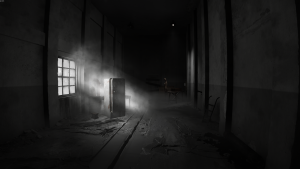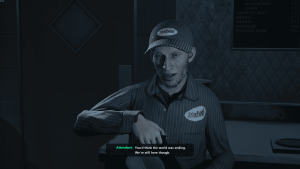A.I.L.A (PC) Review
Summary: An enjoyable horror experience, A.I.L.A surprises with fantastic voice acting and an interesting concept, while still missing the mark on total immersion.
3.8
Decently Scary
I’ve been consuming horror content my whole life, especially the psychological horror genre. I’ve encountered incredible concepts and breathtaking stories, and A.I.L.A had the potential to really come through and absolutely mark itself on the map for the community. While A.I.L.A is not a bad game for anyone unaccustomed to the horror category, I found myself underwhelmed by the ironic clichés and mediocre gunplay along with puzzles. While clearly taking inspiration from many different sources, it manages to replicate them on a surface level, not diving deep enough to really creep you out.
Story:
You follow Samuel, a game tester and tech nerd evaluating a new piece of immersive VR technology: A.I.L.A, a seemingly “sentient” AI that looks deep into your psyche and presents your greatest fears to you with terrifying accuracy.
A pretty neat concept, right? I thought so too, and while the game certainly follows that concept well, it doesn’t really do much with it either. While you’re in between being scared, you have the option of exploring Samuel’s house, a “smart house” built from advanced hardware that is an extension of Samuel himself. While exploring his home is a nice change of pace when you’re not subject to terror, it often feels like too big a space with too few things to interact with. Sure, you could open and close the drawers, fridges, and sliding doors all you want, and there are pieces of lore you could read and interpret, but more often than not I just found myself back in Samuel’s office to keep playing the game you’re meant to be playing, even if later you’ll find yourself in the house more often.
I understand that the house isn’t meant to be incredibly important right off the bat, but I felt those instances where you’re simply meant to enjoy the atmosphere were missed opportunities to explore and understand Samuel as a person, especially for a story-driven game. While later in the game you might learn a bit more about who he is, it doesn’t feel substantial enough at that point.
Gameplay:
As mentioned before, the time in between the actual horror content wasn’t incredibly enjoyable, but when you get to the actual meat of the game, it can be pretty cool. It does use some pretty neat concepts, including an abandoned building atmosphere, Saw-like puzzles and traps, and interesting loop mechanics, especially in the first half of the game. While these ideas are fun, similar to the house, they all feel very light in terms of depth. Using the first level as an example, you don’t spend much time in it, and the puzzles and obstacles you have to overcome are somewhat simple and mechanically lacking. Ironically, I feel like the idea of using multiple environments and settings works against it here. Because you spend so little time experiencing and learning the stories and trials of one level, you don’t get enough time to really absorb all the horror aspects that could have made it great.
Future levels feature the same problems. While the environments are cool and definitely worth the time it took to make them, you simply do not see enough of them to really feel like you’re there. Speaking of immersion-breaking, there are moments and actions that take way longer than they should, and weird choices that impact the flow of gameplay. There are a few examples, but I’m going to use one that made me laugh.
Samuel owns a cat in his house that you can interact with (yes, you can pet the cat) throughout the house. Typically, whenever you wake up, your objective is to feed the cat with a bag of cat food that is in one of your cupboards. Sounds simple enough, right? Well, there are zero waypoints in the game and the objective text provided to you will simply say something like “Feed the cat,” meaning you have to look for the bag of food yourself with no guidance. The first time it had me do it, I could not find the bag at all and I had already searched the entire house twice. And even after I had found the food, the game shifted to a weirdly long cutscene of me just pouring the kibble into a bowl, extending the time it took to finish this one objective. And it plays that cutscene every time you fill the bowl up, which isn’t incredibly often, but it’s frequent enough to notice after hours of playtime.
While in hindsight it might seem obvious to me now (and there might be some people saying I’m just dumb for not finding the food), moments like this, which should take no longer than 20–30 seconds, took minutes off my life for the simple fact that I had no idea where Samuel kept his cat food. A lack of waypoints, direction, and ambiguity are things you really have to be careful with, and to me it feels like the game doesn’t really compensate when it comes to problems like that.
Graphic & Sound Design:
For everything that it is, the game is incredibly pretty and well-designed for what it wants to push for. Each horror environment is crafted expertly with tension in mind, especially with the lighting. The levels feel dead and barren, letting players feel like no matter where they go, a threat could be around the corner waiting to strike. Even without the anxiety, it is a graphical art piece that serves to showcase just how well Unreal Engine 5 works and the tools they have at their disposal.
The developers use a technology called MetaHuman to help create their human NPCs, which helps create realistic humanoids that look incredible. Since they look so human, I’d almost say they look out of place in video games, but because they border on “uncanny valley” territory, they feel like they fit right into the overall theme of a game built around technology that seeks to replicate humanity. The decision to include lifelike models is so genius, it’s almost incredible that no other game has done it before. However, points are deducted for the usage of AI, which, although it seems to fit in with the theme of the game, goes without saying that having someone create the assets needed would have been more difficult, but more impressive for what they were trying to do.
The voice acting and sound design are incredible as well. Each character you interact with, as well as your own, is 100% voice-acted and performed by incredibly talented actors. Every level that you experience has sound effects pertaining to your surroundings that always seek to keep you on your toes. Very well executed and crafted.
Verdict:
A.I.L.A is, in most aspects of the word, average. The great designs and art aren’t enough to really draw you into the gameplay, which seeks inspiration from many different sources. While a game like this could have felt like a love letter to horror and video games, instead it borders on boring and doesn’t feed you enough substance to keep you entertained. The puzzles, gameplay, and decision-making aren’t scary or impactful enough to make me go “WOW!”, instead allowing for an experience I can finish but wouldn’t go back to.











